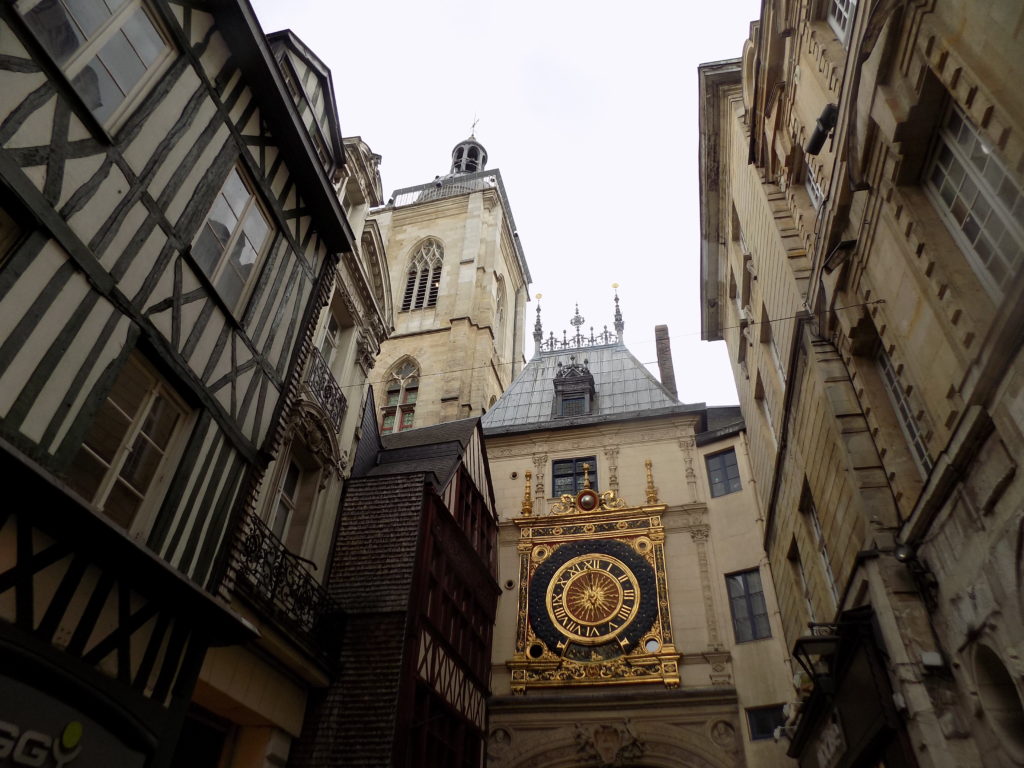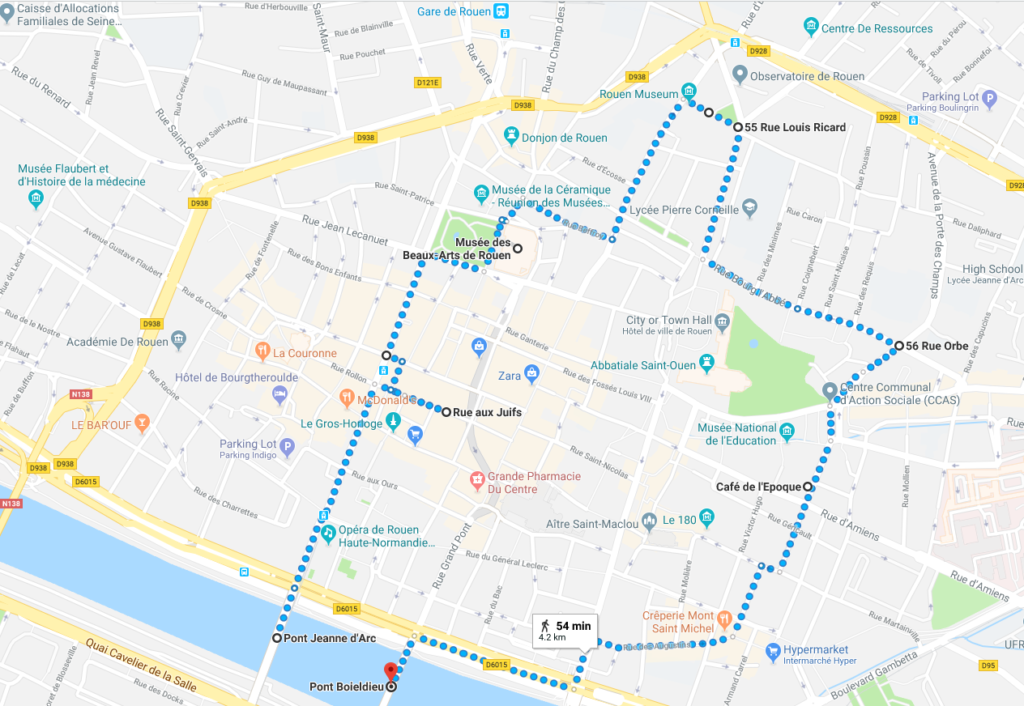The previous post ended with our time at the Aître Saint-Maclou and my rant about tour guides. We’d seen one of the tetrad of Late or Flamboyant Gothic style buildings. Now we’re on our way to the second – likely the most famous of the four.
The Cathedral you’ve all been waiting for.
Here’s a fun fact about the building officially named Cathédrale Primatiale Notre-Dame-de-l’Assomption de Rouen. (I’ll use Notre-Dame de Rouen.) With its spire soaring 151 meters above the earth, Notre-Dame de Rouen held the title as the world’s tallest building from 1876 until 1880. (It was first surpassed by the cathedral in Köln, Germany.) The original wooden Renaissance spire was destroyed by lightning in 1822 and was replaced by the neo-Gothic cast iron spire we see today. It remains the tallest cathedral in France.
While construction on the current building began in the 12th century, churches have occupied the spot in some form since at least as early as the fourth century. Both Saint Ouen (650) and Charlemagne (769) visited the site.
The Vikings, who first came a-raiding down the Seine in the ninth century, destroyed the building that Saint Ouen had enlarged but they eventually built another church on the site. Hrólfr, whom I’ve previously mentioned (aka Rollo, aka Gaange Rolf – meaning Walking Rolf because as he aged he became too heavy for a horse to carry) was both baptized there in 915 and buried there in 932. Rollo is generally considered the first Duke of the land of the northern men (aka Normandie). The Treaty of Saint-Clair-sur-Epte between King Charles III (Charles the Simple) and Rollo granted Rollo title to the lands between the Risle and Epte rivers in exchange for Rollo’s guarantee to protect the kingdom from any new invasion by the Norsemen.
(This photo is from Wikimedia. You can see my photos of the cathedral and from elsewhere in Rouen here. This one provides a better sense of the size of the building making it easier for me to guide you.)
Work on Saint Germain’s Tower on the left began in 1145 in a simple Gothic style. Like the cathedral in Paris, the construction of Notre-Dame de Rouen spanned centuries and one need only glance at the top story to see a dramatic change to the late Gothic or Flamboyant Gothic style.
The entirely Flamboyant Gothic tower on the right, called the Butter Tower, was built between 1485 and 1506. Two sources have been proposed for its unique name. One says that it describes the color of the stone used to construct it because in some light it gives the appearance of having been sculpted out of butter. The other is tied to the dairy industry for which Normandy is justifiably famous.
In this account, or perhaps accounting, the story says the Church formally prohibited consumption of dairy products during Lent. Though quite religious, the citizens of Rouen simply found giving up the famous Normandy butter too great a burden. They reconciled their appetites by making generous donations and the Church quite willingly granted indulgences in exchange ultimately using the funds to erect the tower.
The lightning strike that destroyed the spire in 1822 is not the only catastrophe to damage Notre-Dame de Rouen. Over the course of its history, it has survived a fire in 1200, damage by the Calvinists during the French Wars of Religion in the 16th century, and, most recently, bombing by the Allies in the days preceding D-Day. While much of the shell of Saint Germain’s Tower remained, all of the interior, including the bells burned. The current slate roof was completed in 1987.
The cathedral was the place where the Dukes of Normandy were traditionally crowned and where many of them are interred. There’s a plaque commemorating the former crypt of the Duke of Bedford, John Plantagenet, one of the main overseers in the trial of Jeanne d’Arc. Calvinists demolished his original black marble tomb in the 16th century. Rollo is buried there as is the lion heart of King Richard I of England. Richard’s intestines are buried in Châlus (where he died) and the rest of his body was buried at the feet of his father at Fontevraud Abbey in Anjou.
How Gros do you think it is?
As we began our walk toward the spot where Jeanne d’Arc was burned, we walked west from Notre-Dame de Rouen along the Rue du Gros-Horloge (Big Clock Street). And we didn’t need to walk far to see the reason the street is so named.
The movement of the clock dates to 1389 and is one of the oldest still extant in Europe. Originally constructed without a dial, one revolution of the clock’s hour-hand represented 24 hours. It was installed in the Renaissance arch that spans the street in 1529 and that’s when the 2-and-a-half-meter diameter clock face was added. The belfry, on the left in the photo, houses bells linked to the clock’s movement which was electrified in 1920.
We neared the end of the guided walk proceeding west toward the old Market Square and the Church and execution site of Jeanne d’Arc. Before I write about the afternoon and evening, I want to point out one final site.
This is La Couronne. Established in 1345, it bills itself as “La plus vielle auberge de France” – The oldest restaurant in France. It holds another more recent distinction. In November 1948 an American couple arrived in the port of Le Havre. The husband, Paul, had just been assigned to serve as an exhibits officer for the U S Information Agency in Paris. During World War II, Paul’s wife Julia, had worked for General William J Donovan in the Office of Strategic Services.
On their way to Paris, they stopped in Rouen for dinner at La Couronne. Julia later described the meal as “an opening up of the soul and spirit for me.” Sometime after arriving in Paris, Julia Child enrolled in Le Cordon Bleu cooking school and American kitchens and televisions were forever changed. There’s a lovely review of the restaurant by David Lyon from 2009 on Boston.com.
On our own.
According to legend, in 1235 a Scotsman (or an Irishman) named Patrick Walton found himself shipwrecked in the Bay de l’Aiguillon in southwestern France. Walton had made his living trapping seabirds in nets strung from wooden posts driven into the ground near the shoreline. When he tried to do the same near Charente, he found that, rather than attracting sea birds, mussels grew on the poles. Thus was born the practice of mussel cultivation called bouchot.
Today, Normandy is one of the three largest mussel producing areas of France so when our trip organizer Matthew had promised a feast of mussels between the end of our walking tour and our free afternoon, Pat and I made a beeline back to the ship. Although I don’t think the chef on board had the mussels prepared in either the traditional Moules-Normande style or in the Normandy version of moules-marinière which uses Normandy cider in place of wine, we still had a tasty treat that would only be the first of two special food events while in Rouen.
After lunch, Patricia and I set out to explore a bit more of Rouen with our first goal being a walk up the hill to the Musée des Beaux-Arts de Rouen to have a look at its Impressionist collection – billing itself as the second largest in France (a claim also made by the André Malraux Modern Art Museum in Le Havre). The map below approximates our four-or-five-kilometer route.
We had a bit of a surprise walking up the hill along Rue Jeanne d’Arc or at least it was a surprise to me. Walking both ahead and across from us were two small patrols of soldiers I presumed were from the French Army. They were dressed in full camouflage fatigues and were armed, as the saying goes, to the teeth.
I’d seen similar patrols in Paris but paid them less mind perhaps because I presumed that the events of November 2015 and the position of Paris as the capital made visible reminders of security more expected. Seeing them in Rouen, a city housing just more than 100,000 people and roughly 130 kilometers from Paris was a bit more jarring. It might be that their presence gave the locals a sense of comfort and security but for me it hinted at an unexpected level of danger.
Surprisingly, the Musée des Beaux-Arts had no entrance fee but sadly, significant swaths of the museum were closed for renovation or new installations. Those of you who looked at the photo album saw the two pictures I took in the museum – one of a Monet painting of Notre-Dame de Rouen and this one by Pissarro of the Pont Boieldieu.
This painting interested me because our ship was docked between the Pont Pierre Corneille and the Pont Boieldieu.
Note: In keeping with my 2022-2023 reformation of the blog into shorter entries, backdated to maintain their sequence, any comments on this post might pertain to its new configuration. See the full explanation in the post Conventions and Conversions.





Another excellent article full of varied and interesting content. I found it interesting that all one has to do to break lent is give money to the Church…I found myself wondering what the conversion rate is for a round of one of those wonderful soft cheeses…
You were correct that your discussion of food was not what I expected, it was better. Many countries have adopted the French concept of Appellation d’origine Contrôlée (AoC) and it is a topic that I find fascinating. I have read about Champagne and even Italy’s version of AoC with San Marzano tomatoes but I loved reading about Normandy’s history of their region’s cheeses and liqueurs.
The timing is funny as I have made my own Mozzarella (from curds purchased online) and faux Ricotta (milk/cream and vinegar) for years but just recently decided to try my hand at true scratch made cheeses using rennet, citric acid etc. While I haven’t tried sourcing raw milk (the US gov’t frowns on it here in the states), I know there are several dairies within a couple hours driving that sell unpasteurized milk and cream. Camembert is a favorite and now on my list of must tries…
Thank you again for sharing (and the inspiration). I look forward to the next step in your European adventure.
Thanks, Todd; an excellent aide-mémoire, should I ever get around to writing anything up about the trip myself. (:-) And, yes, a great Perf Chat. I’d never heard the Debussy before and found it fascinating and concentrated in a way that I usually associate with (say) Webern.
I appreciate the feedback from you both.